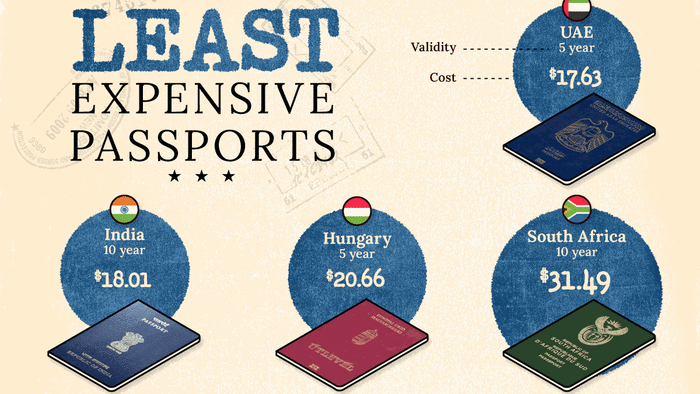Traveling across the globe comes with diverse costs, largely influenced by the fees associated with obtaining a passport, which serves as a crucial tool for international mobility. The charges for passports vary significantly from country to country. An infographic by Kayla Zhu, published on Visual Capitalist, highlights the ten least expensive passports worldwide, detailing their costs in U.S. dollars and their respective validity periods. The data, sourced from Compare The Market, is up-to-date as of April 2024, showcasing notable differences in the affordability of passport acquisition on a global scale.
Leading the list of the most affordable passports is the United Arab Emirates (UAE), which issues passports for an astonishingly low cost of $17.63, valid for five years. This places the UAE at the forefront of affordable passport options globally. Interestingly, the regional diversity of these cost-effective passports is considerable, with European countries like Hungary, Spain, Poland, and Sweden featuring prominently alongside African nations including Kenya and South Africa. This pattern reflects not only economic factors but also governmental policies regulating passport issuance and fees in different regions.
India holds a unique position in the passport affordability landscape, offering a ten-year passport at a cost of just $18.01, which translates to exceptional value on a yearly basis. This suggests that while the initial expense may vary considerably across nations, some countries provide more advantageous options in terms of long-term validity and overall cost. Additionally, Spain provides two passport options, both priced at $32.17; however, the passport for individuals aged 30 and above presents a more favorable proposition due to its ten-year validity.
The global relevance of passports extends beyond their cost and validity periods; they are also indicators of the level of global mobility a country provides to its citizens. For instance, Spain not only ranks among the least expensive passports but also offers one of the strongest passports in terms of travel freedom. Spaniards enjoy visa-free access to 194 countries, placing the Spanish passport in a six-way tie for the title of the world’s most powerful passport. This duality of affordability and strength is a significant consideration for those looking to obtain a passport.
In summary, the infographic illustrates that the costs associated with passports can greatly differ based on one’s geographical location and the respective regulations of each country. While the UAE claims the title for the cheapest passport, nations like India and Spain also offer compelling value propositions when considering long-term validity and travel accessibility. These factors underscore the importance of evaluating both the financial and practical aspects of obtaining a passport before embarking on international travel.
Ultimately, understanding the landscape of passport costs not only aids potential travelers in budgeting for their international experiences, but also serves as a reminder of the broader implications of global mobility. The differences in passport fees reflect underlying economic conditions and immigration policies, which can significantly enrich or limit an individual’s ability to traverse borders. As such, this data provides an essential snapshot of the interconnected worlds of travel affordability and global citizenship.

